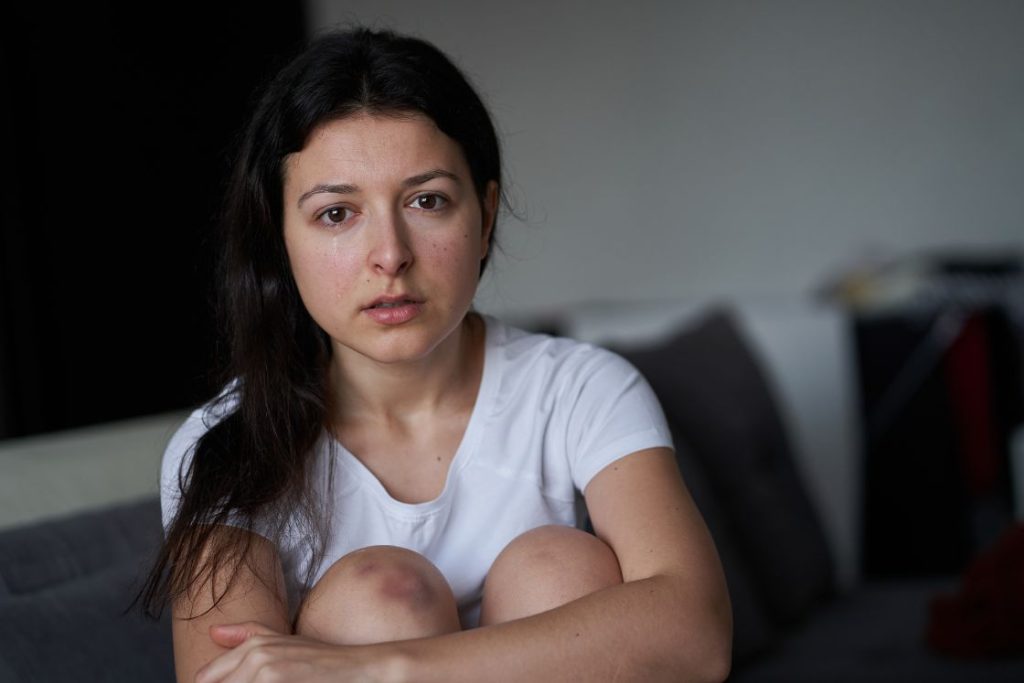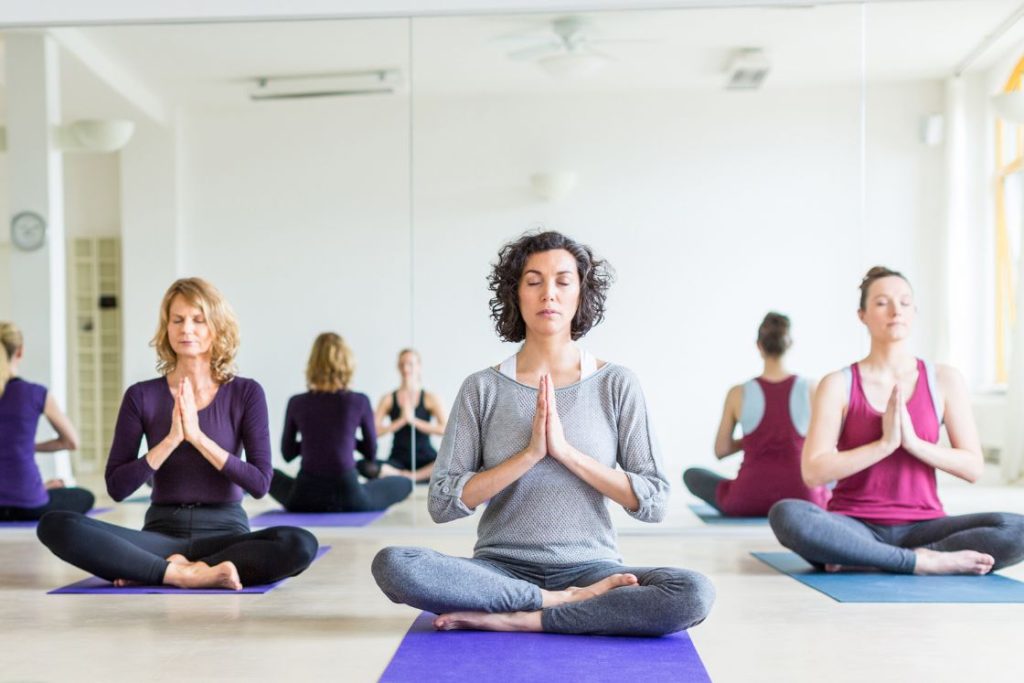- What is Trauma-Informed Yoga?
- Impact of Trauma
- Principles of Trauma-Informed Yoga
- Techniques for Trauma-Informed Yoga

When we hear the term “trauma,” we think of the worst times in our lives The most severe wounds, however, can occasionally be caused by quite mundane events. Trauma can affect every aspect of your life.
Many people can begin to develop a sense of security and find comfort by turning to trauma-informed approaches. Yoga is one of them.
Yoga is known for its positive effects on the body and its ability to relieve stress. When taught by qualified teachers and used in a therapeutic setting, it also has the potential to be a treatment method for people who have experienced trauma.
Yoga uses breath and movement to target the changes in the brain and neurological system caused by trauma.
What is Trauma-Informed Yoga?

By connecting with the breath and developing body awareness, trauma-informed yoga aims to create a safe, encouraging environment in which students can develop their emotional regulation skills.
Trauma-Informed Yoga is a method of teaching yoga that considers that most of us have experienced at least one type of trauma in our lives. Using tools that can help with healing, trauma-informed yoga seeks to address the needs that are unique to trauma survivors.
It is possible to practice trauma-informed yoga in almost any style; there isn’t only one. A trauma-sensitive yoga session is thoughtfully designed to provide a sense of safety, comfort, and calm to support in the processing and letting go of traumatic situations.
Self-control techniques can be used in this type of yoga:
Developing a safe and controlled body awareness to feel more secure physically, mentally and emotionally.
To treat dysregulation of the nervous system, dissociation and the feeling of being disconnected from one’s body or the environment, which often occur after trauma.
It is not the goal of Trauma-Informed Yoga to return you to the source of the pain. The goal is to raise your awareness of what is going on in your body. After you engage with this, you can begin to release pent-up emotions, stress and tension.
Understanding Trauma
The American Psychological Association (APA) defines trauma as “an emotional reaction to a terrible event such as an accident, rape, or natural disaster”.
But any event that a person finds to be physically or emotionally threatening or damaging may trigger trauma as a reaction. Traumatic incidents can occur once or often throughout time. After witnessing something unpleasant occur to someone else, a person may likewise suffer from trauma.
It is your emotional reaction to the event that determines whether it qualifies as traumatic, not the objective conditions. You are more prone to experience trauma the more terrified and helpless you feel.
You can experience traumatic events at any age, and they can have a long-lasting impact on your physical and emotional health. Although each person’s experience is different, post-traumatic stress disorder has some common origins and widespread symptoms, including anxiety, flashbacks, and disturbed sleep.
While situations that make you feel overwhelmed and alone can cause trauma, even those that do not include physical injury but leave you feeling threatened with your life or safety can be traumatic.
Trauma can further be classified into the following types:
Acute Trauma – This is caused by a single incident or terrible event.
Chronic Trauma – This arises from repeated or prolonged exposure to trauma such as bullying, child abuse, sexual or physical abuse, etc.
Complex Trauma – This is when you have been exposed to multiple traumatic events over a long period.
Vicarious (Secondary) Trauma – in this type, you experience trauma because you have witnessed something terrible. While you were directly not involved in the incident or event, the scene/site of the event was horrible to trigger your response.
The Impact of Trauma on Physical and Mental Health

Because your nervous system is overworked, your body and mind are unable to completely digest the traumatic events as they are occurring. This results in post-traumatic stress symptoms. The fight, flight, or freeze reaction is activated by acute stress, which overwhelms the body and mind.
The person’s health can be negatively impacted by trauma for a long time. Depending on how long you take to absorb the upsetting incident, the symptoms usually endure from a few days to a few months.
The symptoms of trauma can be both psychological and physical.
Psychological symptoms include:
- Intrusive thoughts, flashbacks, or nightmares
- Avoiding trauma-inducing/triggering people, places, or objects
- Hypervigilance, being hyperaware of danger
- Easily startled or “jumpy”, anxiety, fear
- Consciously or subconsciously activated by trauma triggers
- Changes in self-perception, such as feeling excess guilt or shame or seeing yourself in a negative way
- Minimal tolerance, feeling easily overwhelmed, or having difficulty controlling your emotions
- Shock, denial, or disbelief
- Edginess, agitation, Confusion, difficulty concentrating
- Anger, irritability, mood swings
- Withdrawing from others
- Feeling sad, hopeless, disconnected, or numb
Physical or somatic symptoms include:
- Fatigue, Insomnia
- Chronic Headache
- Racing heartbeat, chest pains
- Aches and pains, Muscle tension
- Digestive problems
- Sweating when reminded or triggered by a traumatic event
The Principles of Trauma-Informed Yoga
One of the simplest ways to make certain that yoga classes and services are inherently accessible and supportive is to incorporate the concepts of trauma-informed care into the yoga space. These principles are general guidelines for the teacher to make their class as safe, secure, and calm as possible.
Some Such principles are:
- Understanding the effects of trauma on people and communities.
- Encouraging and Creating a safe and supportive environment.
- Empowering students to make choices, take control, and exercise autonomy.
- Emphasizing body awareness and breath.
- Fostering a sense of community.
- Ensuring that all staff is culturally sensitive.
- Being optimistic about recovery.
Techniques for Trauma-Informed Yoga
The main difference between a general hatha yoga class and a trauma-informed yoga class is the way the asanas and breathwork are taught and performed.
Grounding Techniques
Grounding techniques play a role when you see someone getting anxious or restless. This is quite common as emotions are bound to come up when energy moves within the body. Try using the 5-4-3-2-1 grounding technique on your learner if they seem disturbed to pull them back to the present.
Ask the student to name (to themselves):
- 5 things they see
- 4 things they hear
- 3 things they can feel
- 2 things they smell
- 1 thing they taste (or it can be anything that aligns with the practice or student)
Doing this will gently bring them back to focus on their surroundings and gradually calm them down. They can also be used more readily off the mat if they are practiced in a setting where people feel safe.
Gentle Movements
A sitting breathing exercise is used at the beginning of trauma-sensitive yoga, which is then continued by slow, fluid movements.
The teacher leads the class through a sequence of physical postures at a level of intensity appropriate to the student’s abilities while following the parameters of the five fundamental aspects environment, exercises, teaching style, modifications, and language.
Using Props for Support
Props are often used in yoga asanas to support a posture, however, in trauma-informed yoga, care must be taken to use the right kind of props. More often than not, ropes, belts, and straps can be triggering to abuse survivors and thus should be avoided.
Before starting a session, make sure that you are well acquainted with the props you might be using during the class. Blankets, blocks, or even the walls are the best and most commonly available props in any yoga studio. If you are uncomfortable with any props, make sure you inform the instructor as soon as possible.
Mindful Breathing
Breathing might be a difficult effort, but it can provide you with the ability to become aware of impulses in your body. We can learn things from those sensations, even if they are unpleasant or painful. Senses like tranquility or warmth are also perceptible.
You could be able to explore and observe some of the facts preserved in your body if you have the opportunity to link breath to your motions.
The Role of the Yoga Instructor

It’s critical to remember that every factor, from the pace of the class to components like lighting and music loudness, can be a trigger for someone. Thus, it is strongly advised that teachers enroll in rigorous trauma-informed training or study under a trauma-informed teacher due to the numerous variations in how people experience and show trauma.
The chance that students can have traumatic reactions while taking a yoga class is something that a trauma-sensitive yoga instructor is fully aware of. In order to help pupils find their balance, the teacher emphasizes breathing while also urging them to stay connected to their bodies.
Instructors give pupils a feeling of empowerment over their experience while being conscious of their language and words.
A person can practice yoga in a class with fewer trauma triggers thanks to the specialized teaching methods used in this style of yoga, and they can use the tools provided to deal with the impacts of trauma by being mindful and grounding.
Here are the following ways through which a yoga teacher can create a safe space for trauma survivors:
Creating a safe and supportive space
The teacher should show compassion and understanding of their trauma experiences while not directly digging too much into their past. It is a big no-no for teachers to ask invasive questions, privately or publicly, regarding their trauma.
The teacher should make the practitioners understand that while they will never be able to understand their minds and hearts, the space they have created is like an offering. The choice to follow our cues or ignore them ought to remain available to students if they believe they aren’t helpful at the time.
Just showing that you genuinely care for the student’s needs can be enough to build a sense of security and safety.
Being aware of students’ triggers
Being aware of the triggers is a big aspect of trauma-informed yoga. Unless you are aware of the triggers, you will not be able to build trust with the student. Loud sounds or voices, constant walking, physical touch, large crowds, closing eyes, lying prone, silence, etc. are some common triggering points that may set off a chain of reactions in a student.
The teacher must enquire regarding triggers before the student comes for the first class. You are not trying to diagnose their trauma, instead, you want to make them feel safe and secure in a space where they will be spending a considerable amount of time. This will also help build confidence and trust in the student for their teacher as well.
Avoiding language and touch that may be triggering
Being deprived of one’s bodily autonomy is a common cause of trauma. In order to help your pupils, refrain from contacting their bodies in any way. Based on their past interactions with you, they might not feel confident setting limits with you.
Get consent before providing each physical assistance if you do so. Students are given the chance to change their views and it is acknowledged that everyone has different comfort levels when it comes to being touched in various ways.
The same goes for the language and tone you use.
Sometimes, trauma survivors can get triggered even with the slightest raise of voice. A commanding voice may remind them of a triggering event. You should learn to phrase your cues and commands in a way that comes off as suggestions or advice.
Always look for options to make the student feel less vulnerable and more empowered.
Encouraging self-care and self-compassion
By asking students to notice, observe, or investigate how slight postural changes feel in their bodies, teachers can promote interoception. Giving students the chance to observe their perspective helps promote bodily awareness instead of connecting our personal experiences to activities or recommending that postures should feel a specific way.
This encourages the students to become self-aware of their minds and bodies. By giving them a safe space to explore their inner self, they can be encouraged to show compassion towards themselves.
Trauma-Informed Yoga in Practice

While the research is in its infancy for the efficacy of trauma-informed yoga, the evidence that has come up to date suggests that this type of yoga can be a beneficial addition to trauma care.
In a study published in 2015, major improvements in patients’ anxiety and general well-being were found. Women receiving outpatient detoxification for heroin dependency found trauma-informed yoga to be an effective supplementary treatment, and after six months of yoga, the yoga treatment group significantly improved their quality of life and emotional states.
Another research published in the International Journal of Yoga Therapy in 2021 successfully found that trauma-informed yoga promoted healing in marginalized groups who suffered trauma due to racial abuse.
According to a review from 2016, trauma-sensitive yoga can assist women who have endured intimate partner violence to lessen PTSD symptoms.
According to a 2018 study, trauma-sensitive yoga initiatives can be used alone or in conjunction with other therapies to treat PTSD symptoms in veterans.
Not only studies, but many practitioners of trauma-informed yoga have also discussed the benefits of taking this form of yoga.
According to Marine Sgt. Senio Martz’s account in the Huffington Post story, trauma-informed yoga has aided him to cope with his PTSD since his homecoming from Afghanistan, when a fatal roadside bomb exploded, knocking him out cold and killing Marines under his leadership.
Melissa Noel Renzi, who runs her trauma-informed yoga classes, advocates strongly for this type of yoga. She is an introvert and a highly sensitive person (HSP) who can get easily agitated with sensory overload and has found solace in this type of yoga to center her mind and body.
The Impact of Trauma-informed Yoga on Mental and Physical Health
Trauma-informed yoga can have significant positive effects on mental and physical health. Here are some ways trauma-informed yoga can benefit individuals:
Mental Health:
Reducing symptoms of post-traumatic stress disorder (PTSD): Trauma-informed yoga can help alleviate symptoms associated with PTSD, such as intrusive thoughts, over-excitement, and hypervigilance. The combination of physical movement, breathwork, and mindfulness practices can promote relaxation and reduce the effects of trauma-related triggers.
Improved Mood and Emotional Well-being: Trauma-informed yoga can improve mood regulation, enhance positive feelings, and reduce symptoms of depression and anxiety. Focusing on grounding techniques and present moment awareness can help participants manage and process difficult emotions.
Improved Self-Esteem and Self-Compassion: trauma often affects a person’s self-awareness and self-esteem. Trauma-informed yoga promotes self-compassion, self-acceptance and self-care. The practice encourages individuals to honor their bodies and respect their boundaries, promoting a positive relationship with themselves.
Greater Mindfulness and Presence: trauma yoga emphasizes mindfulness, which is paying attention to the present moment without judgment. This practice can help individuals develop greater awareness of their thoughts, emotions, and body sensations, which promotes a sense of grounding and reduces rumination.
Improved Coping Skills: Trauma-informed yoga gives individuals practical tools and coping strategies to manage stress, anxiety and other difficult emotions. Breathing exercises, relaxation techniques, and mindful movements can be applied outside of yoga practice, allowing individuals to better manage triggers and stressors in everyday life.
Physical Health:
Stress Reduction and Relaxation: trauma-informed yoga incorporates relaxation techniques, deep breathing, and gentle movements that activate the body’s relaxation response. This can help reduce the physiological effects of stress, such as lowering heart rate, blood pressure and cortisol levels.
Increased body awareness and sensation: trauma can lead to dissociation or disconnection from the body. Trauma yoga enhances body awareness and helps individuals reconnect with their physical sensations and needs. This can support overall physical well-being and allow for early detection of physical symptoms or discomfort.
Improved Sleep Quality: the relaxing and stress-reducing effects of trauma-informed yoga can contribute to improved sleep quality. The practice can help people relax, calm their minds, and develop a sleep routine that contributes to better sleep hygiene.
Improved Physical Strength, Flexibility and Balance: Trauma informed-yoga involves gentle physical movements that can gradually improve strength, flexibility and balance. These physical benefits can support overall physical health, reduce the risk of injury, and increase overall vitality.
It’s important to remember that trauma-informed yoga should be practiced in conjunction with other forms of therapy or treatment as part of a comprehensive approach to healing from trauma. It’s highly recommended to work with a qualified yoga instructor and mental health professional to ensure safety and effectiveness.
Long-term Benefits of Trauma-Informed Yoga
Emotional Regulation: Trauma survivors often struggle with emotional dysregulation and experience intense emotions such as anxiety, fear, or anger. Trauma-informed yoga provides a safe space for trauma survivors to explore and manage their emotions, helping them develop self-regulation skills over time.
Stress Reduction: Yoga is widely known to reduce stress. Trauma-informed yoga includes specific practices and modifications that focus on grounding, breathing techniques, and gentle movements. These elements can help trauma survivors lower their overall stress levels and develop a sense of calm and relaxation.
Mind-body connection: Trauma often disconnects individuals from their bodies, which can lead to feelings of dissociation or lack of awareness of bodily sensations. Trauma-informed yoga focuses on restoring connection to the body, promoting a sense of embodiment, and restoring a healthy relationship with bodily sensations. This can improve self-awareness and promote a greater sense of well-being.
Empowerment and Self-Responsibility: Trauma-Informed Yoga encourages individuals to make choices based on their personal well-being and safety during practice. This focus on autonomy and empowerment can help trauma survivors regain a sense of control over their bodies and lives, leading to greater self-confidence and a sense of agency.
Healing from Trauma: Trauma-informed yoga can be a valuable part of a comprehensive approach to trauma healing. Through gentle movement, breathwork, and mindfulness, people can release stored tension and trauma-related emotions to support their path to healing and recovery.
Improved body awareness: Trauma survivors may lack connection to their bodies due to traumatic experiences. Trauma-informed yoga includes exercises that promote body awareness, such as grounding techniques, body scans, and gentle movement techniques. By becoming more attuned to their bodies, individuals can develop a better understanding of their physical sensations, needs, and limitations.
Conclusion
Trauma is a condition that affects a lot of people, but it also comes with specific characteristics. Regaining control over one’s body and decisions is essential for recovery.
A safe environment with instructors or therapists who respect your limits is required for trauma-informed yoga practice. You can learn from them how to regulate and deal with the changes that are occurring in your body and mind. You begin re-establishing those mind/body connections as you incorporate movement and breathing.
Check the instructor’s credentials for trauma-informed yoga when searching for this kind of yoga practice. Yoga may aid in the healing of trauma when practiced in the appropriate environment and under the guidance of a qualified instructor.
To feel secure and supported, pay close attention to your body and adjust your technique as necessary.
The post Trauma-Informed Yoga: Everything You Need to Know appeared first on Fitsri.